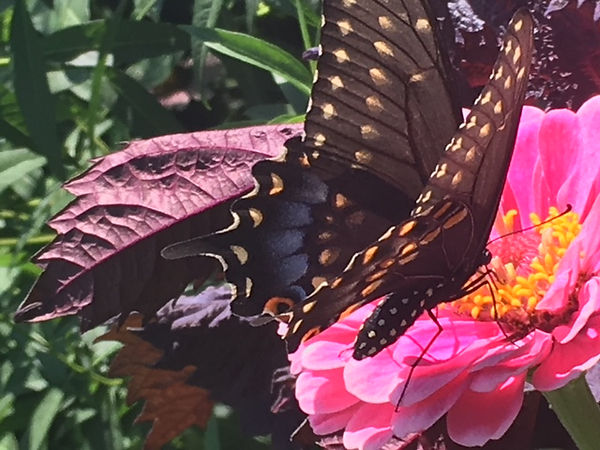
What's in Flight
August 2018
The most beautiful creatures on the wing in Carl Schurz Park this month are the butterflies. Among the most striking are the four or five species of brightly colored swallowtails (a family that includes some of the largest butterflies in the world).

Black Swallowtail
Lucie Young
The Black Swallowtail can measure up to three and a half inches wide, with a flash of blue and two orange eye spots on its forked hind wings. ‘We think these fake eyes may confuse predators about which direction the butterfly is facing. So if it is attacked it can move off in the opposite direction. Swallowtails, like many other butterflies, fly very erratically. Humans think it looks poetic, but it’s probably a defense mechanism,’ says Rick Cech, naturalist and author of Butterflies of the East Coast. Along with the Black Swallowtail, look out for the Spicebush Swallowtail, the pale yellow and black striped Eastern Tiger Swallowtail and the shimmering blue Pipevine Swallowtail (a rare, but exciting visitor to NYC parks).

Tiger Swallowtail
Richard Cech

Pipevine Swallowtail
Richard Cech
August and early September are also peak season for Monarch butterflies, which undertake one of the most perilous and complex migrations of any species. This round-trip journey of over 5,000 miles is like a familial relay race, which can take up to five generations of butterflies to complete. ‘It is a fascinating mystery, how each newborn generation knows where to go when they migrate. None of them has ever been on this journey before’ says Emma Pelton, a conservation biologist at the Xerces Society, for invertebrate conservation.

Monarch
Stephaine McKnight, The Xerces Society
Our East Coast Monarchs are the descendants of butterflies who spend the winter huddled in their millions clinging to Oyamel fir trees in forests near Mexico City. At winter’s end these butterflies fly north looking for milkweed to lay their eggs in. ‘They arrive in Texas and Oaklahoma in April, where one butterfly can lay as many as 300 eggs before they die. Monarch butterflies typically live just two to six weeks,’ says Emma Pelton. Progressive generations move further and further north, following the milkweed (some reach as high as Canada). With every generation the numbers swell until they are at their peak in August and early September.
The final generation, which are nectaring in our park now, are called the ‘Super Generation’ because they live eight times longer and travel ten times further, making the whole journey back to Mexico in the fall, so they can start the next generational relay race in the Spring. These tiny creatures, weighing just 0.026 oz, can fly as high as 1 mile up in the air coasting on air currents.

Monarch caterpillar
Richard Cech

Monarch chrysalis
Stephaine McKnight, The Xerces Society
Monarchs, whose population has dropped 80 percent in the last twenty years live off nectaring plants, and in late summer they rely on late flowering ones such as asters, ironweed, goldenrod, purple coneflower (a complete list is on the Xerces website), and native milkweed (particularly common milkweed). ‘It is important people don’t plant tropical milkweed, which lives much longer and fools Monarchs into staying too far north in places where they will eventually die of the cold’ says Emma Pelton.

Monarch
Richard Cech
In Carl Schurz the main butterfly spots to see Monarchs, Swallowtails, the pretty Orange Sulphur and abundant Cabbage Whites are the colorful flowerbeds along the esplanade, at the end of the 86th street Cherry Allee and around the 89th street entrance.

Orange Sulphur
Richard Cech

Cabbage White
Richard Cech
Words: Lucie Young
Images: Richard Cech, Stephanie McKnight for The Xerces Society, Lucie Young
Links:
Xerces Society Monarch information https://xerces.org/monarchs/
Xerces Society map of the Monarch migration https://www.xerces.org/wp-content/uploads/2015/10/MonarchMap-NatureServe-10.20.png
Xerces Society Monarch plant list http://xerces.org/monarch-nectar-plant-guide-northeast/

